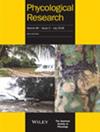Dudresnaya (Dumontiaceae, Florideophyceae)的分类研究,包括 Dudresnaya ryukyuensis sp.
IF 1
4区 生物学
Q2 MARINE & FRESHWATER BIOLOGY
引用次数: 0
摘要
Dudresnaya 红藻属(Dumontiaceae, Gigartinales)历来是一个形态上定义明确的类群,但其分子系统发育却鲜有研究。为了研究 Dudresnaya 物种之间的系统发育关系,我们从日本冲绳岛一个未被描述的 Dudresnaya 物种和另外五个已描述的物种中获得了线粒体 cox1、叶绿体 rbcL 和核 28S rRNA 基因的部分序列。我们的系统发育分析表明,Dudresnaya 在遗传上具有多样性和多型性。根据分子系统发育和形态学数据,我们将冲绳岛的 Dudresnaya 描述为一个新种 Dudresnaya ryukyuensis,并将在系统发育和形态学上与真正的 Dudresnaya 不同的 Dudresnaya minima 和 Dudresnaya littleri 分别归入新属 Himehibirhodia 和 Nudresdaya。我们的系统发育分析还表明,杜仲科(Dumontiaceae)并不是一个单系群,其中包括 Gainiaceae 和 Rhizophyllidaceae(DGR 复合群)。考虑到 DGR 复合体的雌性生殖结构及其受精后的发育过程彼此相似,DGR 复合体似乎可被认定为 Dumontiaceae sensu lato。本文章由计算机程序翻译,如有差异,请以英文原文为准。
Taxonomic study of the polyphyletic Dudresnaya (Dumontiaceae, Florideophyceae) with descriptions of Dudresnaya ryukyuensis sp. nov. and two new genera, Himehibirhodia and Nudresdaya
The red algal genus Dudresnaya (Dumontiaceae, Gigartinales) has traditionally been a morphologically well-defined taxon, but its molecular phylogeny has rarely been studied. To examine the phylogenetic relationships among Dudresnaya species, we generated new partial sequences of mitochondrial cox1, chloroplast rbcL and nuclear 28S rRNA genes from an undescribed Dudresnaya species from Okinawa Island, Japan, alongside five additional described species. Our phylogenetic analyses show that Dudresnaya is genetically diverse and polyphyletic. Based on molecular phylogeny and morphological data, we describe the Okinawan Dudresnaya as a new species, Dudresnaya ryukyuensis, and transferred Dudresnaya minima and Dudresnaya littleri, which were phylogenetically and morphologically distinct from the genuine Dudresnaya, to the new genera Himehibirhodia and Nudresdaya, respectively. Our phylogenetic analyses also showed that the Dumontiaceae is not a monophyletic group including the Gainiaceae and Rhizophyllidaceae (DGR complex). Considering that the DGR complex exhibits female reproductive structures and their post-fertilization development that are similar to each other, the DGR complex appears to be recognized as the Dumontiaceae sensu lato.
求助全文
通过发布文献求助,成功后即可免费获取论文全文。
去求助
来源期刊

Phycological Research
生物-海洋与淡水生物学
CiteScore
3.60
自引率
13.30%
发文量
33
审稿时长
>12 weeks
期刊介绍:
Phycological Research is published by the Japanese Society of Phycology and complements the Japanese Journal of Phycology. The Journal publishes international, basic or applied, peer-reviewed research dealing with all aspects of phycology including ecology, taxonomy and phylogeny, evolution, genetics, molecular biology, biochemistry, cell biology, morphology, physiology, new techniques to facilitate the international exchange of results. All articles are peer-reviewed by at least two researchers expert in the filed of the submitted paper. Phycological Research has been credited by the International Association for Plant Taxonomy for the purpose of registration of new non-vascular plant names (including fossils).
 求助内容:
求助内容: 应助结果提醒方式:
应助结果提醒方式:


